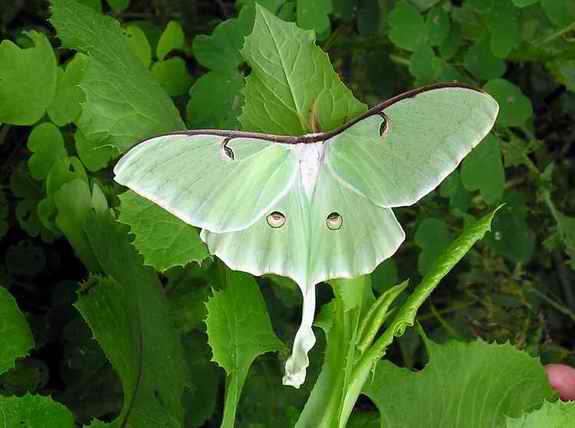|
Common Name: Luna Moth, American Moon Moth, Saturniid Moth Scientific Name: Actias luna (The species and common name luna means "of or pertaining to the moon" and refers to the two crescent shaped markings on the wings).
Luna moths are members of the family Saturniidae, Giant Silkworm Moths, which are closely related to commercial silkworm moths (Bombyx mori). The family name means sisters of Saturn, who was an ancient agricultural divinity of Roman origin. The name probably refers to the goddess-like beauty and diaphanous delicacy of the moths. Saturniids are found primarily in tropical regions and are characterized by their thick, silk cocoons and by the fact that most of them have a large eyespot on the wings to ward off predators. The Luna moth is found only in North America. Saturniids were widely used before the advent of genetic DNA analysis as a means of studying hybridization and variation.
The life cycle of the Luna Moth begins when the female lays clusters of about 5 eggs in different locations on the underside of food plant leaves until all of her 150-250 eggs have been deposited. The leaves chosen are those that comprise the preferred food source of the larvae, primarily hickory, walnut and sweet gum but also persimmon, beech, willows and white oaks. The larvae hatch after about two weeks later and begin to eat voraciously, growing to a length of about 9 centimeters in five stages or instars each of which lasts about a week and ends with molting occurring at the end of each stage. At the end of this period, the caterpillar spins a silken cocoon to become a pupa.
The adult Luna Moth escapes from the cocoon by secreting a chemical called cocoonase that breaks down sericin which is a binder for the silk after about two weeks of pupation. It is not ready to fly at this point as its wings are still folded and wet and it needs rest following the exertions of the escape. It instinctively climbs up on a small shrub or tree trunk in mid-morning to hang its wings so they can fill with blood and dry in the sun.
The adult stage of the Luna Moth has a singular focus; reproduction and survival of the species. The male moths generally emerge a few days before the females. One distinguishing feature of the male is that it has larger, bushier antennae. This is because they use their antenna to detect the pheromones, or scents, that are emitted by the females. Electrophysiological studies of Giant Silkworm Moths have revealed that each antenna has about 40,000 sex-odor receptors which are tuned to specific odors to the extent that they are able to detect a pheromone at a concentration as low as 100 molecules in a cubic centimeter. As the males have evolved to find the females in the dark, this adaptation is understandable.
When the female Luna Moth is fully rested in the evening, a scent gland is extended and the pheromones are released from the posterior of the abdomen. The males are attracted by the scent and descend to mate, a process that takes about 24 hours. The male dies shortly thereafter. The female moth usually stays in one place and does not fly until after mating. Once mating is completed, the female proceeds to lay the eggs and dies shortly thereafter. The adult Luna Moth lives for about a week. The only activity is to find a mate and reproduce. Adults don't even eat so they don't have mouths.
The short adult life span of the Luna moth is related to their adaptive coloration. Moths and butterflies are either procryptic, with colors and markings that match the native environment and conceal the insect, or aposematic, with vibrant colors that draw attention to denote that the insect is poisonous or tastes bad. The survival strategy of the two types results in differences in longevity. The aposematics live longer than the procryptics in order to condition predators to the visual warning. The procryptics die as quickly as possible so that predators will not be able to figure out how to detect them. Saturniids are represented by both types; studies have revealed that the procryptics fly more so as to exhaust themselves and die quickly while the aposematics conserve their energy. Luna Moths are procryptic.
Luna Moths are single, double or triple brooded according to geographic location, the number of generations correlating to the duration of the summer. In the Southern Appalachians, two broods are the norm, so the adult that emerges from the overwintering cocoon will lay eggs which will hatch, pupate and mate by mid May. The second brood will go through the same cycle about ten weeks later. As part of the overall survival scheme of the insect, 25 to 40 percent of the first brood larvae make a decision to over winter in lieu of emerging as adults that same summer. They indicate this by turning from the normal green of the larvae to a dark burgundy coloration just before they spin their cocoons for pupation. The over wintering pupae will thus remain in the metamorphic state for as long as 8 months, all to enhance survival of the species. |
